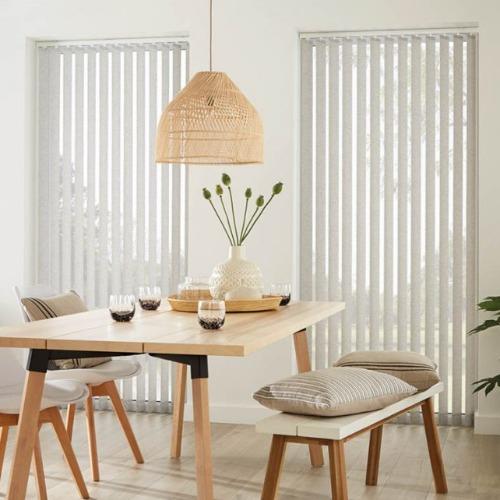What Are Vertical Blinds?
When it comes to window coverings, most people opt for blinds to control light and provide privacy. They can be used for covering windows as well as sliding doors. Plus, they add aesthetic appeal to your home and are pretty multifunctional.
If you think of blinds, you probably picture horizontal blinds, where each slat moves from left to right instead of up and down. However, vertical blinds have become an eye-catching and trendy choice that more people are considering nowadays.
What Are Vertical Blinds?
This type of blind consists of louvres or slats that can be twisted to seal the window and prevent light from coming in or opened wide to let plenty of light in. They are connected by a chain and can be opened and closed by pulling a cable to the right or left of the blind. Like curtains, vertical blinds can be divided into two halves – one half is moving to one side while the other half is moving to the other.
A wide variety of fabrics can be used to make louvres and slats. Many of these textiles look good and have unique properties that can help you deal with window problems.
Ideal Window For Vertical Blinds
A vertical blind is an excellent option for large windows that cannot accommodate horizontal or roller shades. Since the louvres are weighted together, they’re easier to adjust and fit windows of any size. It’s also possible to use vertical blinds to cover difficult-to-cover windows, such as those with a diagonal or divided drop. You can customize the louvres to fit the dimensions of your window if you know how to measure for vertical blinds .
Pros And Cons
Now that you’ve learned what a vertical blind is, you’ll want to install one in your home’s windows. But before you decide, let’s consider some of its pros and cons.
- Pros
Vertical blinds have the obvious benefits of controlling light and privacy. But installing them has other benefits, such as:
- Easy To Maintain
PVC is the most common material for vertical blinds, making them easier to clean and less likely to accumulate dust. You can use additional cleaning agents without worrying about discolouration.
- Increased Height
Vertical blinds entirely cover the height and width of windows and sliding doors, giving them a heightened appearance than horizontal blinds alone.
- Easy Replacement
Vertical blinds can be fixed easily by swapping out single-blind panels. Your long vertical shades can be replaced or repaired by contacting the company that makes the blinds.
- Lots Of Colours And Materials
Blinds for vertical windows can be found in various colours and materials, making them suitable for a wide range of interior design styles.
- Cons
Despite its many perks, vertical blinds have their share of drawbacks.
- Noisy
The vertical columns can swing and crash with each other when the blinds are opened, making an annoying sound. A fan running or a window open can produce a similar effect, which can be a little disturbing if the blinds are installed in a bedroom.
- Touches the Floor
Vertical blinds can collect dust and grime from the floor. Cleaning and maintaining this might be a nuisance.
- Not Suitable For Small Windows
Because these blinds take up horizontal space, they may not be enough or visually appealing for smaller windows.
Cleaning And Maintenance
Many people are worried about how much work it will be to keep vertical blinds clean. The truth is that they don’t need too much care to maintain them. A damp towel is usually required to clean vertical blind slants and louvres. That will remove the majority of the dirt and dust attached to them.
Even though you might have to put in a lot of effort when cleaning the blind railing, it’s a one-time task that doesn’t have to be repeated quite often. The blinds must be removed from the rail, and the rail should be cleaned by rubbing a moist cloth over it.
Clean the side rail as well if you want to ensure the smooth operation of the blind mechanism. When you rehang the louvres, be careful not to destroy the fabric.
Conclusion
Blinds are the most popular choice for window treatments if you’re looking for a way to regulate light and privacy. They can be used to cover windows and sliding doors. In addition, they are both visually appealing and functionally diverse.
Blinds are typically considered horizontal, with each slat moving left to right rather than up and down. But vertical blinds have become a popular and eye-catching addition to homes in the past few years.
If you’re thinking about installing blinds, vertical blinds are a good option. Refer to this post as your guide to vertical blinds.
You might also like...
-
Choosing the Perfect Curtains for Your Home

Choosing the perfect curtains for one’s home can be a complex yet rewarding task. The right curtains not only enhance the overall aesthetics of a ...
-
Plantation Shutters: How to Use Bold Colours in Your Home Without Overwhelming the Space

Bold colours can bring energy, vibrancy, and personality to your home, transforming any room into a lively, inviting space. However, their intensity can ...
-
Sustainable Living: Transforming Homes with Eco-Friendly Choices with Curtain Master

Sustainable living is a commitment to a better future. As homeowners seek ways to reduce their carbon footprint, making thoughtful choices in home decor can ...
-
Screen Door Solutions Designed for Every Lifestyle

South Africa’s beautiful climate naturally encourages open doors and breezy living, but unwanted insects can quickly spoil the moment. That’s where Corner Star steps in, ...























